There are no lack of visitors to Cuba from rich countries, including a disproportionate number from Britain and Canada who believe they have encountered a true alternative to capitalist democracy. Why? It seems to be a way of keeping alive the idea of some ideal society, without having to experience the disadvantages oneself. Call it temporary slumming, a metaphorical Hemingway in Return to Catalonia, the flip side of the other macho Hemingway who was enthralled at the gore and pageantry of the bullfight. It may also be a facet of a general dislike of the US, or a way of expressing unease with capitalist excesses.
But it is also, in all probability, related to a nostalgia for the political certainties and the handsome design of the 1950s and before: the cars, the bars and the glamour. It is not for nothing that Cuba sells itself with the music of the pre-revolutionary period. If North Korea had charm and salsa and innuendo and beaches, perhaps a lot of politically naive people would be advocating its merits too.
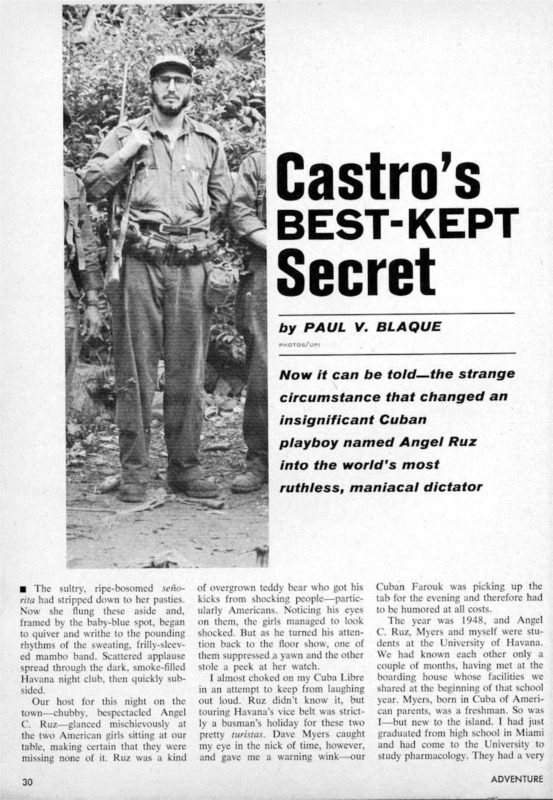
menspulpmags.com:---It was published in the December 1965 issue of Adventure magazine and is titled “CASTRO’S BEST-KEPT SEX SECRET.” It supposedly explains how a sex-related event in 1948 turned Castro into a megalomaniacal madman and ultimately resulted in the Cuban Revolution.---
Hypocritically, some policy advocates are saying they have a problem with: “certain aspects of governance and human rights in Cuba”. If these same intellos had made the same statement regarding South Africa during the apartheid era it wouldn’t have been controversial at all, or controversial, but only human-rights as a pure play issue. But human rights and democracy is always chained to the cash register… In any event, the basis of a country like Canada’s foreign policy to Cuba is predicated on the same basis as was American foreign policy to South Africa. It’s a concept known as “constructive engagement”.
In the case of South Africa it facilitated an acquiescence that allowed the minority power base to extend/consolidate its political authority in the face of a globally acknowledged lack of moral authority. In the case of Cuba we should not be misguided; Canadian foreign policy, often an acceptable public proxy for background American interests, rests on economic opportunism rather than a looming moral and philosophical objection to the climate inside Cuba. This always explains the appearance of articles that paint a rosy, and touristy picture of Cuba that crop up in various U.S. newspapers in; because each piece makes a largely emotional and romantic presentation of the island, they likely attract a good number of U.S. readers seeking to reaffirm the Cuba of their imaginations.
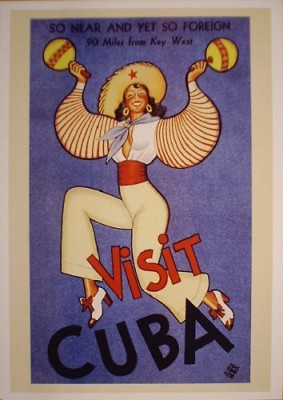
"...partly because living under a dictatorship generates extraordinary levels of patience, and partly because questioning the regime can lose you your job or even land you in prison. Also, whatever the iniquities of the current system, there is still a certain sort of fear about what may be in store once the regime passes and, in some cases, there is even an affection for a tyrannical parent figure."
Cuba enchants the U.S. public, especially as a place that is in many ways out of reach, a small island anomaly in a hemisphere of democracies, and a country about which so little is really known because of the lack of information flow in and out. These articles report what estadounidenses want to hear, and although they leave out much, they may ultimately contribute to the lifting of the travel ban, if they can successfully pull at the heartstrings of a quorum of readers.
“Through the eyes of Raul Cañibano Ercilla, one can see life in Cuba from an intimate perspective, with all its complexities, wonders, struggles, humanity, love and sense of integrity.In his black-and-white photographs, Mr. Cañibano captures Cuba’s national identity; one that may very well be threatened by the inevitable thrust of economic development and an international tourist economy.” ( Adriana Teresa )
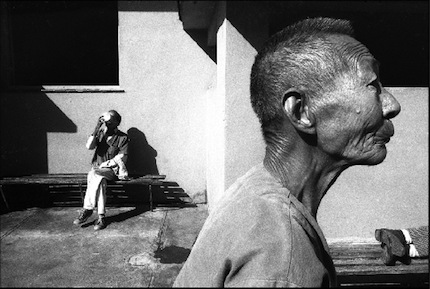
---In his documentation, he feels responsible for providing an accurate portrayal of Cuban life. Today, Mr. Cañibano works as an advertising photographer in Havana.---
Though Cuba continues to be romanticized — as in Che, Steven Soderbergh’s two-part film, which whitewashes Che Guevara’s terrorist activity as only the naïfs of Hollywood can do, no one now seriously believes that the Castro and brother regime, which is over fifty now, has benefited the country. Castro did raise public health standards and literacy levels, but the economy has stagnated for decades, and Cuba is, in constant units of a reliable currency, poorer than before Cas
��s victory in 1959, though such wealth as exists admittedly is more evenly distributed.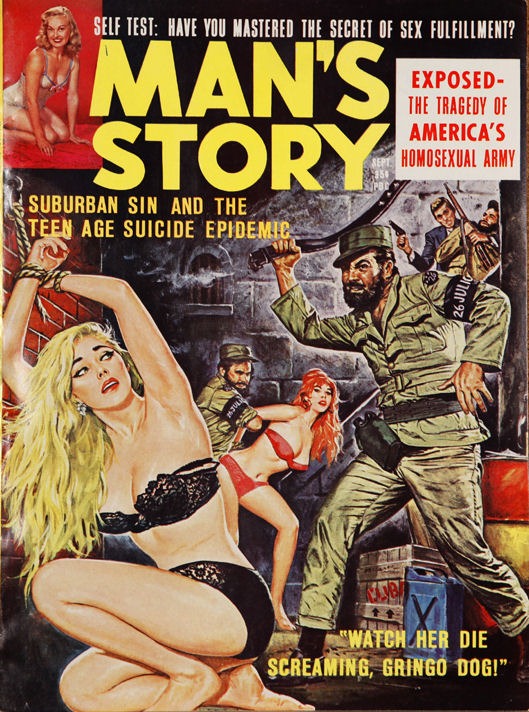
"Cuba could have ended the U.S. embargo at any time by offering one cent on the dollar for seized U.S. assets, but refused to make any conciliatory gesture, and has become an abominable, even depraved regime, reduced in recent years to the official renting out of thousands of citizens as sex slaves to pleasure tourists as a means to make their visit more memorable."
The real Cuban prosperity of the last half century is in Florida, where more than two million Cuban Americans have made a tremendous contribution to the growth of that state from the 16th to the fourth most populous. The interests of democratic capitalism, by extension have never worked hard to swim upstream and its reflection in low-brow popular culture is revealing:
“Men’s adventure magazines increased their circulation during the height of those uneasy days known as the Cold War. The magazines themselves helped disseminate Cold War code words, issuing anxiety, paranoia, Red Threat, and Yellow Peril every month, though it did so in many issues with a Terry Southern sort of satirical exaggeration. Fidel Castro replaced Nazi and Jap with his own variety of sadistic torture of very white American women, peppered with suggestive Spanish commentary.” ( Adam Parfrey )
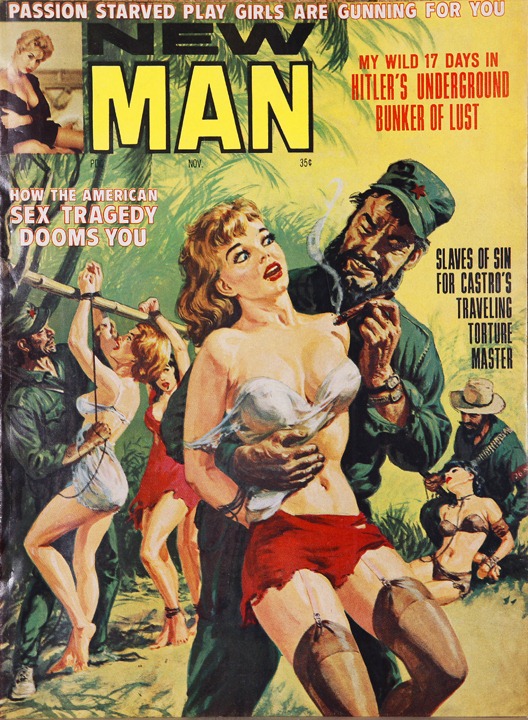
---One of the most famous (or infamous) is the the cover painting Norman Saunders created for the November 1964 issue of New Man magazine. It shows a leering Castro lookalike getting ready to burn the heaving breast of a scantily-clad white woman with a Cuban cigar. In the background, his comrades are subjecting two other hapless damsels to other forms of bondage and torture. It’s a gonzo scene that goes with the gonzo story inside, “SLAVES OF SIN FOR CASTRO'S TRAVELING TORTURE MASTER.”---
The Che movie is a play on the enduring legacy of the romanticism of Cuba, and to the extent it whitewashes the past and enhances the myth as media creation, it is understandable that it sparked protests by Cuban-Americans in Miami. It takes a relatively sympathetic view of Fidel Castro, his right hand man Ernesto ‘Che’ Guevara, and the Cuban Revolution that toppled dictator Fulgencio Batista on New Year’s Day in 1959 — and eventually led to Cuba’s continuing Communist dictatorship under Fidel and his brother Raul.
Back in the late 1950s and the early days of Castro’s regime, there were some sympathetic stories about Fidel and his Cuban rebels in men’s adventure magazines, as there were in the mainstream media.That all ended in the 1960 election campaign when hawks were clamoring for an invasion. When Kennedy goaded Nixon on this score during a debate, Nixon sagely replied that a military mission to unseat Castro would affront international law, violate the Organization of American States’s non-intervention clause and be unsuccessful if conducted by mercenaries. This turned out to be absolutely correct — though Nixon didn’t believe a word of what he said. A few months later, when Kennedy was president, the Bay of Pigs debacle validated everything Nixon had predicted in his impassioned but insincere debate reply.

---Another classic evil Cuban Commie cover painting, also by Norman Saunders, is on the the September 1965 issue of New Man. It’s even further out than the November ‘64 example. So is the title of the story it was done for: "KISS THE SKULL OF DEATH, MY BEAUTIFUL MUCHACHA!"---
ADDENDUM:
President Kennedy acted from intuition, misinformed about the extent of the Soviet force in Cuba, and preserved the peace. His and his advisers’ supposedly inspired, almost scientific, decision-making and crisis management, was really just the president following his clever instincts, but the crisis emboldened U.S. policymakers to imagine they were more able than they were to roll out strategic policy, as they soon learned in Vietnam.
Subsequent U.S. policy toward Cuba is generally thought to have been a failure, a sterile embargo that has enabled Castro to blame the failure of his regime on the United States. But again, by dumb luck, as with the missile-crisis response, it has worked. Having given away the invasion option, the United States has showcased Cuba as a model of how not to govern, of the failures of communism and of the dangers of affronting the United States at close quarters.






 COMMENTS
COMMENTS